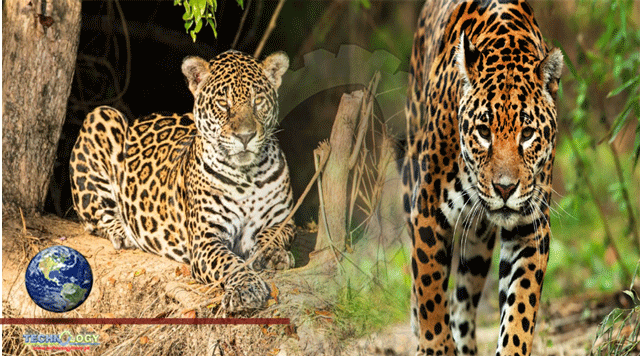In a tract of central Brazilian wetlands, jaguars spend their days wading through chest-deep waters searching for fish. When not hunting, the big cats playfully grapple with each other back on land. Their life is unlike any other known jaguar population’s existence in the world.

New findings reveal a degree of flexibility in diet and lifestyle previously unseen among jaguars. The discovery may provide key context on the cats’ role in food webs, helping scientists better understand the effect of environmental changes on the species, researchers report October 6 in Ecology.
Jaguars (Panthera onca), which are usually territorial loners that hunt on land, live in a wide array of habitats, ranging from North American deserts to grasslands and tropical rainforests in Central and South America. The cats’ are also found in the Pantanal, an immense tropical wetland — the largest of its kind in the world — that sprawls over parts of Brazil, Bolivia and Paraguay.
Ecologists Manoel dos Santos-Filho of the Universidade do Estado de Mato Grosso in Cáceres, Brazil and Carlos Peres of the University of East Anglia in Norwich, England knew of rumors of large numbers of jaguars sighted near Brazil’s Taiamã Ecological Station. That large ecological reserve is located in the remote, northern reaches of the Pantanal.
After relaying these anecdotes to Taal Levi, a wildlife ecologist at Oregon State University in Corvallis, the researchers started a project to better understand the jaguars’ biology and population status in the protected area.
Taiamã is seasonally flooded, with no roads or trails, so the team had to access the reserve by boat, setting up motion-activated cameras along waterways to gather data on jaguar numbers. The area’s abundance of jaguars, however, was obvious immediately.
“You set your foot out of the boat, and there’s a jaguar footprint there already,” says Charlotte Eriksson, a wildlife scientist also at Oregon State University. “There are scratches on trees. There are jaguar scats. There’s just an unbelievable presence of this apex predator wherever you go, which is something I’ve never experienced anywhere before,” Eriksson says.
The team deployed 59 cameras, which operated from 2014 to 2018 and collected more than 1,500 videos of jaguars. The researchers also captured 13 jaguars and fitted them with GPS or radio-tracking collars to gain insight into the animals’ population density, movements and social interactions.
Based on their data, Eriksson and colleagues estimate that the Taiamã Ecological Station hosts the highest density of jaguars ever recorded: 12.4 animals per 100 square kilometers, nearly triple some of the next highest estimates elsewhere. Jaguars were also the most common mammal spotted on the cameras.
Video footage showed jaguars carrying off large fish. When the team analyzed 138 scat samples, the researchers found 55 percent had fish remains in them and 46 percent contained aquatic reptiles, such as caiman or turtles. Just 11 percent contained mammal remains.
Jaguars are well-documented in taking on challenging prey, including underwater fare (SN: 7/15/16). Eriksson and her team think that the Taiamã felines have not only the most fish-dependent diet among jaguars, but also among all big cats. There are tigers in Bangladesh that live in flooded mangrove forests and sometimes eat fish, but those cats still primarily eat land-based food, the researchers say.
The cameras and tracking collars also showed that the Taiamã jaguars were spending a lot of time near each other, sometimes traveling, fishing and playing together. This is all exceptionally odd behavior for jaguars, at least based on what scientists know about the cats elsewhere in the world.
In terms of social behavior, “What we knew of jaguars from before this study is basically that they are solitary, and they meet up to mate. And that’s about it,” Eriksson says, noting anecdotes of the cats sharing prey carcasses as rare counterexamples.
The profusion of aquatic prey in the flooded preserve — protected from human encroachment — may be responsible for the jaguars’ superlative density and their rich social lives. It’s possible there’s so much food available, Eriksson says, that there is “no real need to fight over it.”
Another idea is that aquatic prey concentrated along the river margins are accessible in only certain areas, Levi says. This may encourage jaguar territories to dissolve, since obtaining access to multiple fishing spots requires getting along with other jaguars. Other animals behave in similar ways. Brown bears, for example, congregate in great numbers to feed at salmon spawning grounds, despite the bears’ typically solitary nature, Levi says.
The abundance of jaguars and their social behavior is not surprising, given the available food resources, says Todd Fuller, a conservation biologist at the University of Massachusetts Amherst. Still, he finds the new information exciting.
Fuller, who was not involved with the research, says the study helps bring researchers’ understanding of jaguars’ ecology and conservation closer to what’s known about most other large cat species, and “that is a very good thing.”
Jaguars in the Pantanal face many threats and are declining within Brazil, Eriksson says, suffering from drought, fire and agricultural expansion. Evaluating how jaguars might respond to such changes is paramount. In 2020, half of the study area burned, so Eriksson is currently assessing the impact of the fires on the jaguars and their periodically submerged home.
She also wants to investigate how the Taiamã jaguars’ taste for fish is affecting how often the animals eat land-living prey and what strategies the cats use to catch fish.
“We think we know a lot about these charismatic, large predators,” she says, “but there are still things to learn.”
Originally published by Science News